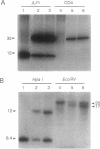Abstract
Gene targeting is a technique by which a preselected site in the genome of a living cell can be modified by inserting, deleting, or exchanging DNA sequences. The application of this technology to cells with a limited life-span, such as nontransformed human somatic cells, requires the development of simplified and efficient procedures to allow the isolation of correctly modified cells from the much larger pool of random integrants. The current study describes the development of a widely applicable strategy for detecting homologous recombinants in human cells by using an ELISA-based screen. When this system is used accurately targeted clones can be detected with high efficiency as soon as 14 days following transfection. Data are presented demonstrating the utility of this detection system in isolating targeted recombinants at the beta 2-microglobulin locus in both human retinal pigmented epithelial cells and human keratinocytes.
Full text
PDF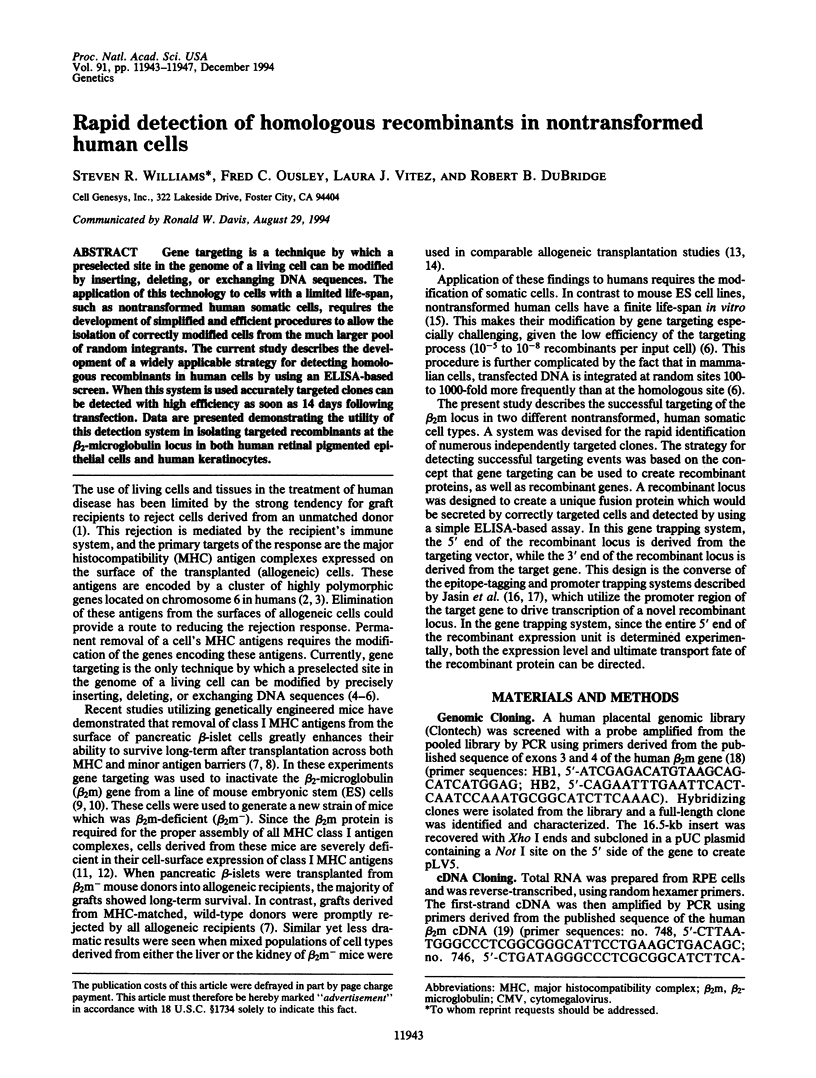
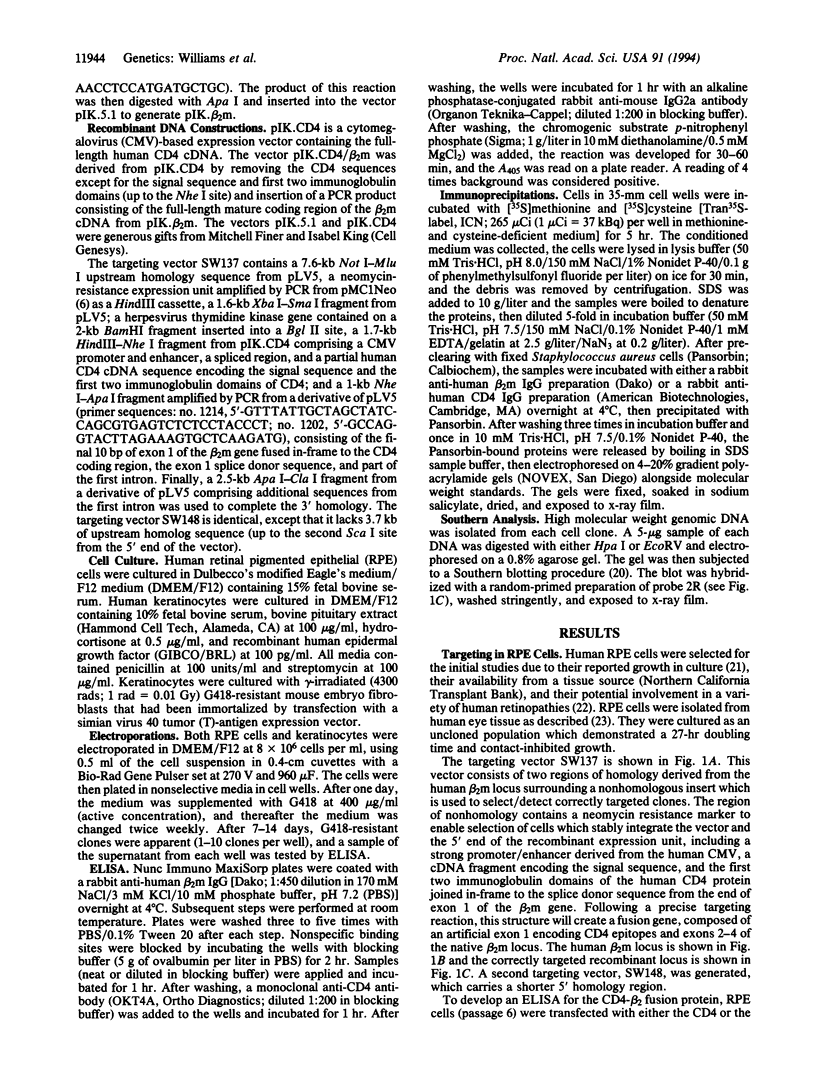
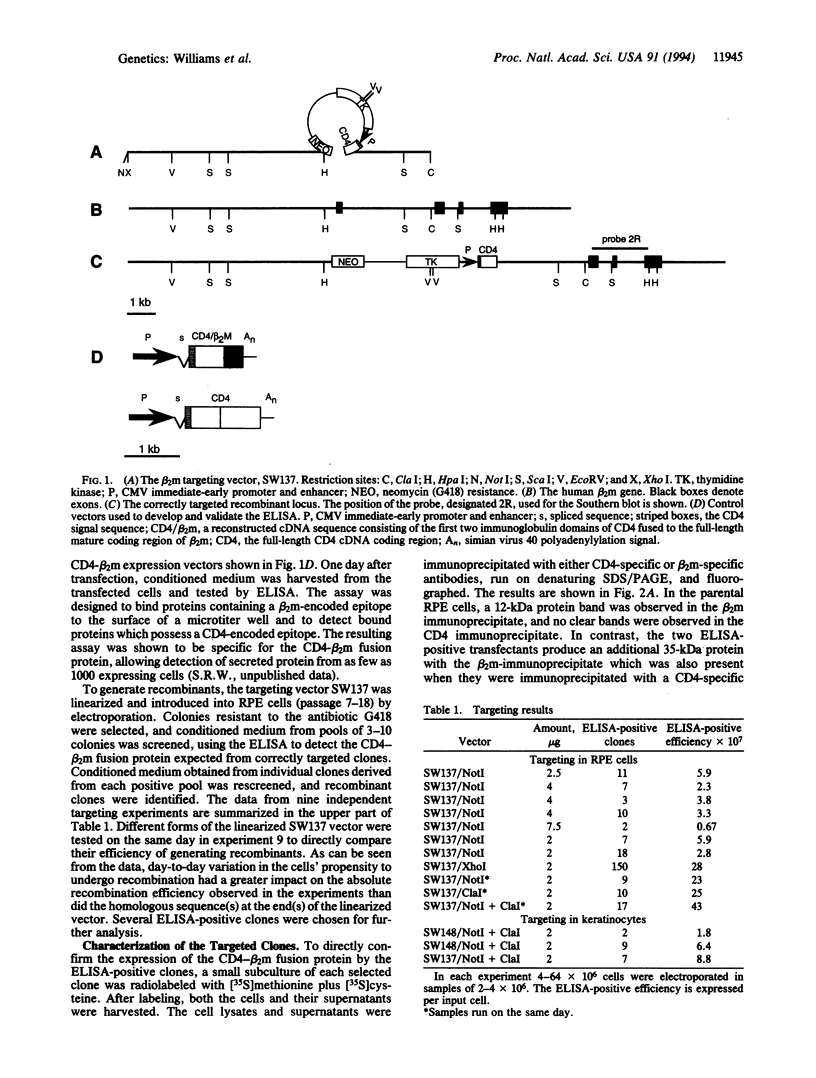
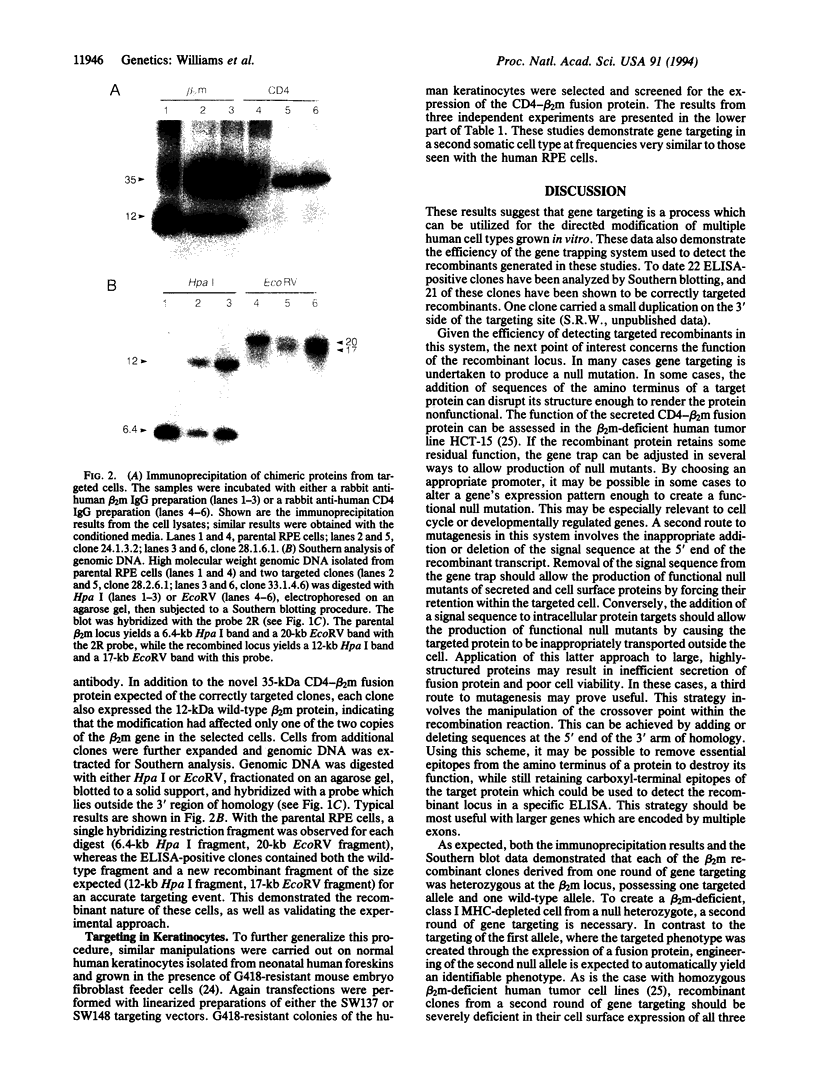
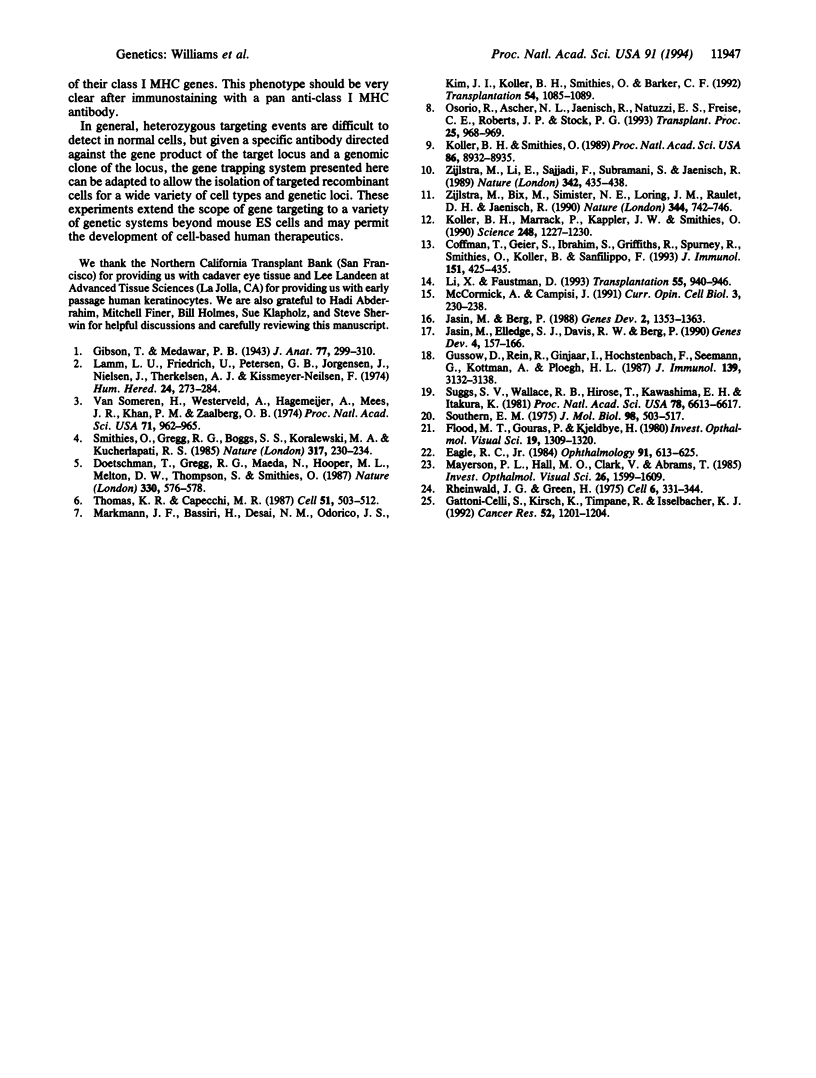
Images in this article
Selected References
These references are in PubMed. This may not be the complete list of references from this article.
- Coffman T., Geier S., Ibrahim S., Griffiths R., Spurney R., Smithies O., Koller B., Sanfilippo F. Improved renal function in mouse kidney allografts lacking MHC class I antigens. J Immunol. 1993 Jul 1;151(1):425–435. [PubMed] [Google Scholar]
- Doetschman T., Gregg R. G., Maeda N., Hooper M. L., Melton D. W., Thompson S., Smithies O. Targetted correction of a mutant HPRT gene in mouse embryonic stem cells. Nature. 1987 Dec 10;330(6148):576–578. doi: 10.1038/330576a0. [DOI] [PubMed] [Google Scholar]
- Eagle R. C., Jr Mechanisms of maculopathy. Ophthalmology. 1984 Jun;91(6):613–625. doi: 10.1016/s0161-6420(84)34259-2. [DOI] [PubMed] [Google Scholar]
- Flood M. T., Gouras P., Kjeldbye H. Growth characteristics and ultrastructure of human retinal pigment epithelium in vitro. Invest Ophthalmol Vis Sci. 1980 Nov;19(11):1309–1320. [PubMed] [Google Scholar]
- Gattoni-Celli S., Kirsch K., Timpane R., Isselbacher K. J. Beta 2-microglobulin gene is mutated in a human colon cancer cell line (HCT) deficient in the expression of HLA class I antigens on the cell surface. Cancer Res. 1992 Mar 1;52(5):1201–1204. [PubMed] [Google Scholar]
- Gibson T., Medawar P. B. The fate of skin homografts in man. J Anat. 1943 Jul;77(Pt 4):299–310.4. [PMC free article] [PubMed] [Google Scholar]
- Güssow D., Rein R., Ginjaar I., Hochstenbach F., Seemann G., Kottman A., Ploegh H. L. The human beta 2-microglobulin gene. Primary structure and definition of the transcriptional unit. J Immunol. 1987 Nov 1;139(9):3132–3138. [PubMed] [Google Scholar]
- Jasin M., Berg P. Homologous integration in mammalian cells without target gene selection. Genes Dev. 1988 Nov;2(11):1353–1363. doi: 10.1101/gad.2.11.1353. [DOI] [PubMed] [Google Scholar]
- Jasin M., Elledge S. J., Davis R. W., Berg P. Gene targeting at the human CD4 locus by epitope addition. Genes Dev. 1990 Feb;4(2):157–166. doi: 10.1101/gad.4.2.157. [DOI] [PubMed] [Google Scholar]
- Koller B. H., Marrack P., Kappler J. W., Smithies O. Normal development of mice deficient in beta 2M, MHC class I proteins, and CD8+ T cells. Science. 1990 Jun 8;248(4960):1227–1230. doi: 10.1126/science.2112266. [DOI] [PubMed] [Google Scholar]
- Koller B. H., Smithies O. Inactivating the beta 2-microglobulin locus in mouse embryonic stem cells by homologous recombination. Proc Natl Acad Sci U S A. 1989 Nov;86(22):8932–8935. doi: 10.1073/pnas.86.22.8932. [DOI] [PMC free article] [PubMed] [Google Scholar]
- Lamm L. U., Friedrich U., Petersen C. B., Jorgensen J., Nielsen J., Therkelsen A. J., Kissmeyer-Nielsen F. Assignment of the major histocompatibility complex to chromosome No. 6 in a family with a pericentric inversion. Hum Hered. 1974;24(3):273–284. doi: 10.1159/000152660. [DOI] [PubMed] [Google Scholar]
- Li X., Faustman D. Use of donor beta 2-microglobulin-deficient transgenic mouse liver cells for isografts, allografts, and xenografts. Transplantation. 1993 Apr;55(4):940–946. doi: 10.1097/00007890-199304000-00046. [DOI] [PubMed] [Google Scholar]
- Markmann J. F., Bassiri H., Desai N. M., Odorico J. S., Kim J. I., Koller B. H., Smithies O., Barker C. F. Indefinite survival of MHC class I-deficient murine pancreatic islet allografts. Transplantation. 1992 Dec;54(6):1085–1089. doi: 10.1097/00007890-199212000-00025. [DOI] [PubMed] [Google Scholar]
- Mayerson P. L., Hall M. O., Clark V., Abrams T. An improved method for isolation and culture of rat retinal pigment epithelial cells. Invest Ophthalmol Vis Sci. 1985 Nov;26(11):1599–1609. [PubMed] [Google Scholar]
- McCormick A., Campisi J. Cellular aging and senescence. Curr Opin Cell Biol. 1991 Apr;3(2):230–234. doi: 10.1016/0955-0674(91)90144-n. [DOI] [PubMed] [Google Scholar]
- Osorio R. W., Ascher N. L., Jaenisch R., Natuzzi E. S., Freise C. E., Roberts J. P., Stock P. G. Isolation of functional MHC class I-deficient islet cells. Transplant Proc. 1993 Feb;25(1 Pt 2):968–969. [PubMed] [Google Scholar]
- Rheinwald J. G., Green H. Serial cultivation of strains of human epidermal keratinocytes: the formation of keratinizing colonies from single cells. Cell. 1975 Nov;6(3):331–343. doi: 10.1016/s0092-8674(75)80001-8. [DOI] [PubMed] [Google Scholar]
- Smithies O., Gregg R. G., Boggs S. S., Koralewski M. A., Kucherlapati R. S. Insertion of DNA sequences into the human chromosomal beta-globin locus by homologous recombination. Nature. 1985 Sep 19;317(6034):230–234. doi: 10.1038/317230a0. [DOI] [PubMed] [Google Scholar]
- Southern E. M. Detection of specific sequences among DNA fragments separated by gel electrophoresis. J Mol Biol. 1975 Nov 5;98(3):503–517. doi: 10.1016/s0022-2836(75)80083-0. [DOI] [PubMed] [Google Scholar]
- Suggs S. V., Wallace R. B., Hirose T., Kawashima E. H., Itakura K. Use of synthetic oligonucleotides as hybridization probes: isolation of cloned cDNA sequences for human beta 2-microglobulin. Proc Natl Acad Sci U S A. 1981 Nov;78(11):6613–6617. doi: 10.1073/pnas.78.11.6613. [DOI] [PMC free article] [PubMed] [Google Scholar]
- Thomas K. R., Capecchi M. R. Site-directed mutagenesis by gene targeting in mouse embryo-derived stem cells. Cell. 1987 Nov 6;51(3):503–512. doi: 10.1016/0092-8674(87)90646-5. [DOI] [PubMed] [Google Scholar]
- Zijlstra M., Bix M., Simister N. E., Loring J. M., Raulet D. H., Jaenisch R. Beta 2-microglobulin deficient mice lack CD4-8+ cytolytic T cells. Nature. 1990 Apr 19;344(6268):742–746. doi: 10.1038/344742a0. [DOI] [PubMed] [Google Scholar]
- Zijlstra M., Li E., Sajjadi F., Subramani S., Jaenisch R. Germ-line transmission of a disrupted beta 2-microglobulin gene produced by homologous recombination in embryonic stem cells. Nature. 1989 Nov 23;342(6248):435–438. doi: 10.1038/342435a0. [DOI] [PubMed] [Google Scholar]
- van Someren H., Westerveld A., Hagemeijer A., Mees J. R., Meera Khan P., Zaalberg O. B. Human antigen and enzyme markers in man-Chinese hamster somatic cell hybrids: evidence for synteny between the HL-A, PGM3, ME1, and IPO-B loci. Proc Natl Acad Sci U S A. 1974 Mar;71(3):962–965. doi: 10.1073/pnas.71.3.962. [DOI] [PMC free article] [PubMed] [Google Scholar]



